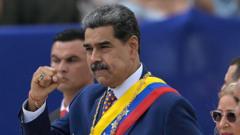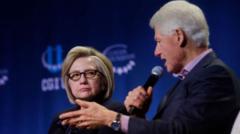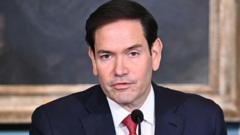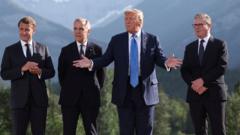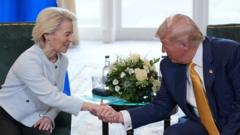The WTO forecasts a decline in global trade due to US tariffs, with potential severe risks from political uncertainty and reciprocal tariffs.
US Tariffs Projected to Shrink Global Trade, Warns WTO
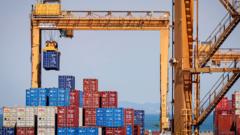
US Tariffs Projected to Shrink Global Trade, Warns WTO
The World Trade Organization raises concerns over tariffs' impact on international commerce.
The World Trade Organization (WTO) has issued a stark warning about the potential shrinkage of global trade, attributing much of the decline to escalating tariffs imposed by the US under President Donald Trump. During a recent press conference in Geneva, WTO Director-General Ngozi Okonjo-Iweala expressed serious concern regarding the deteriorating relations between the US and China, labeling the situation a "really worrying" phenomenon.
According to the WTO's latest analysis, global goods trade could plunge more than predicted, with North America set to experience the most significant downturn, potentially exceeding a 10% drop. This revelation contrasts sharply with previous forecasts that anticipated a 2.7% expansion of global goods trade by 2025. Following the analysis, the WTO's updated projection now anticipates a slight decline of 0.2% instead.
Chief economist Ralph Ossa cautioned that tariffs wield considerable policy leverage with far-reaching and frequently unforeseen consequences on trade dynamics. "Trade policy uncertainty has a pronounced dampening effect on trade flows," he noted, indicating that uncertainty could result in reduced exports and a slowdown in economic activity.
In a parallel report issued by the United Nations Conference on Trade and Development (UNCTAD), global growth is expected to decelerate to 2.3% in 2025 amid rising trade tensions. This forecast falls below the crucial 2.5% threshold, often perceived as an indicator of a possible global recession.
The US's newly reinstated baseline tariff of 10% on a majority of foreign imports took effect on April 5, sparking immediate concern in the financial markets. While some countries and products have exemptions, China's tariffs are notably severe, reaching as high as 145% on various goods.
Despite the visual trajectory indicating a decline in US trade, the WTO believes that parts of Asia and Europe may still witness modest trade growth in their exports and imports this year. Their report also marks the inclusion of predictions regarding services trade, which entails the exchange of non-physical goods, such as tourism or finance. The organization forecasts a growth rate of 4% in services trade by 2025, albeit lower than previous estimates.
Trump has positioned the tariffs as a catalyst for Americans to support domestic manufacturing and invest in the US economy. Critics, however, argue that the complexities of reshoring manufacturing might take decades and could adversely affect the economy in the interim. Notably, the president has occasionally walked back on his tariff announcements, revealing the volatile nature of the situation, especially after announcing a 90-day pause on tariffs against all countries except China.
This evolving scenario raises significant questions about the long-term consequences of trade policy in the current geopolitical landscape, especially regarding international relations and economic health worldwide.


